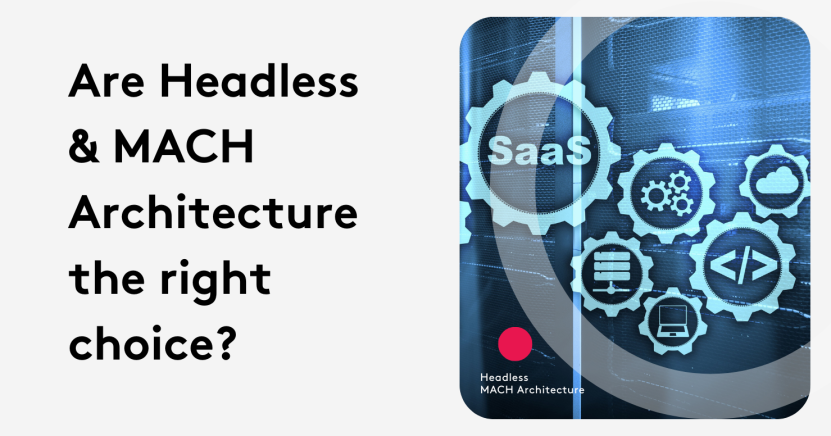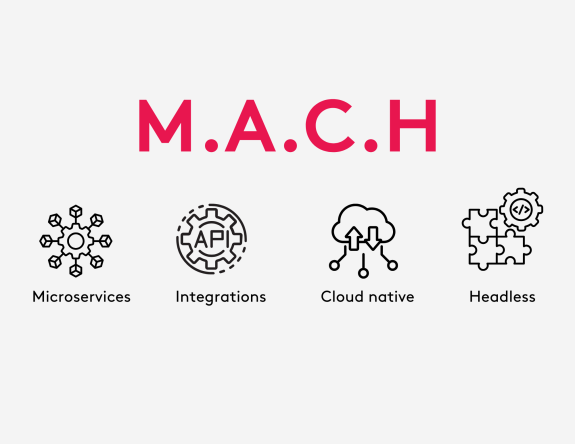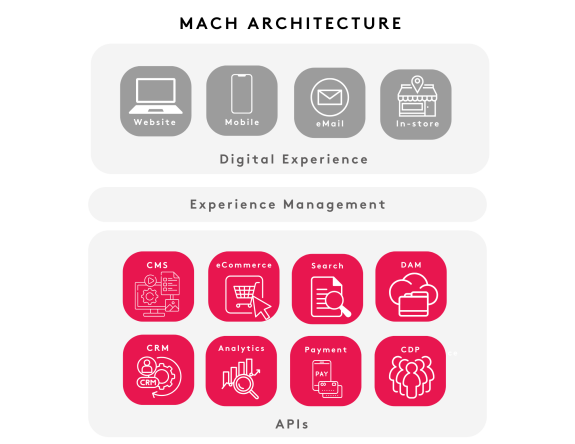Are Headless and MACH Architecture the right choice?

Are you in the process of modernize your digital infrastructure? May be you heard of benefits of MACH architecture for eCommerce? If you want a flexible and future proof solution that stands for Microservices, API-first, Cloud-native, and Headless keep reading.
Like any new technology shift, moving your enterprise technology ecosystem to MACH is a long road. And the road is fraught with challenges.
The cloud native, headless architecture that MACH Technology supported by the MACH Alliance offers is designed to grow with any business. The composable architecture means that each service runs independently, ready to be scaled and customized.
The promises of scalability, adaptability, and rapid solutions mean that this microservice architecture is an attractive choice for businesses. But of course it’s not always that simple.
Let's learn what these challenges might be and how to overcome them.

What is MACH Architecture?
But before we dive in, what actually is MACH architecture?
Basically, MACH architecture breaks down traditional monolithic systems into smaller, independent services (microservices), each of which communicates through APIs. The architecture is cloud-native, meaning it's built to leverage cloud services for enhanced performance and scaling.
The headless nature of MACH allows companies to separate the frontend from the backend. This means faster software development cycles and personalized digital experiences across multiple channels.
In this way, MACH is a great architecture to meet evolving business needs. MACH architecture microservices make it flexible, easy to scale and, versatile which means it fits all kinds of businesses at every stage of their journey.
So, where does it all go wrong? Let’s look at five reasons why MACH architecture projects fail and what you can do about it.
1. Underestimating the MACH Architecture
One of the attractive things about MACH is the ability to separate different services, which means greater flexibility and scalability. Basically, businesses only pay and manage what they need, unlike large monolithic architectures, which are all or nothing and can be expensive and clunky.
Sounds great! So what goes wrong? Put simply, many organizations find themselves unprepared for the operational complexity that comes with managing a distributed system.
When does software development go wrong?
Too many moving parts: A microservices-based architecture is a juggling act. You must manage each service independently, which is much more complex than you might first imagine. What used to be a single, unified system now requires constant coordination, which can overwhelm teams and cause delays.
Making sure everything is well connected: In distributed systems, data is often spread across multiple services. Ensuring proper synchronization is mandatory to avoid inconsistencies, delays or incorrect information across systems.
A powerful system to avoid latency: Each micro-services communicates with others via network calls, which introduces slight delays. When these interactions multiply, overall system performance can degrade if you don’t have a powerful enough infrastructure, undermining the primary benefits of MACH—speed and efficiency.
How to approach website development right
In a sentence: be prepared. Business leaders need to understand that microservices might need a bit more management and time to get right.
Invest in comprehensive service management and monitoring tools that help make microservice coordination easier. Then, put in place clear data control policies and optimizing inter-service communication can reduce inconsistencies and latency by a long way.
And don’t forget to get your team ready. Prepare a contingency plan and steps to resolve any issues that may arise.
Don’t forget that microservice architecture will always require maintenance internally to make sure everything is running smoothly. Putting in place a team structure with defined responsibilities with system oversight will help you keep everything rolling.

2. Big changes require big investments
Words of wisdom: don’t be unprepared for the scale of the change. A MACH implementation (like Rome) can’t be built in a day.
So, what does this mean? Many businesses approach MACH principles with an all-or-nothing mindset, assuming that replacing their legacy systems in one massive overhaul will deliver quick, transformative results. This “big bang” approach often backfires, leading to unmanageable complexity and significant delays.
What can Go Wrong
- Exponential Complexity: to rebuild an entire system in one go is a massive intake. Given the large scope of a project involving MACH, more errors, unexpected challenges, and prolonged timelines can occur.
- No time for upscaling: A phased approach allows teams to learn from early missteps and improve their processes. Overhauling the entire system at once, companies miss the chance to course-correct before larger issues arise.
- Delayed Value Delivery: With everything being reworked simultaneously, it can take a long time before any tangible benefits are realized. Stakeholders may lose confidence as the project stretches on without visible results, defeating MACH principles of delivering value faster.
How to Avoid It
Slow down, implement a serious project plan, and expect to spend more time than you think on organizational changes, like change management. Adopting an incremental migration strategy is a safer and more efficient way to implement MACH.
By breaking the project into smaller, manageable phases, you see early wins, make necessary adjustments in real time, and deliver value incrementally. This reduces the overall risk and allows for a smoother transition.
In your delivery timeline, think about changes to the timelines for those inevitable issues that crop up when you least expect them. A few weeks of grace means that your team will be less stressed and more capable to respond to issues as they arise.
3. Unsufficient preparation
Implementing MACH architecture isn't just about upgrading technology—it requires an organizational shift in the way your organization thinks.
Many companies underestimate the cultural and operational changes necessary for a successful MACH transition.
What can Go Wrong
- Siloed Teams: Conway’s Law, which suggests that a system’s design reflects the communication structure of the organization, becomes especially problematic in a MACH setup. If your teams remain isolated within their respective silos, the reality is that your new architecture will reflect those divisions, meaning you’ll end up with fragmented and inefficient microservices.
- Legacy Project Thinking: Many organizations continue to treat MACH initiatives as traditional, one-off projects with fixed timelines and endpoints, rather than as ongoing products that need continuous improvement and adaptation. This means they don’t see the results they want and are unprepared to deliver through agile methodologies.
- Cultural Resistance: Speaking of agile, moving to MACH often requires teams to embrace fast-paced collaboration, new project management formats, and continuous delivery. The issues come when traditional project management formats like waterfall development are deeply ingrained in the culture, causing friction and reluctance among employees.
How to Avoid It
A mindset shift and an honest appraisal of organizational structures are important steps in a MACH implementation that can’t be skipped.
To succeed with MACH, companies need to align their teams around product domains, not technical functions. Cross-functional teams that collaborate across silos foster better communication and more efficient service development.
Investing in training to help teams adopt an agile mindset is crucial for overcoming cultural resistance and driving MACH’s success. It might seem like an unnecessary expense. However, spending time and money on mindset and cultural changes at the beginning of the project will improve outcomes.
4. Clinging to (Outdated) Waterfall Methods
Linking to the above problem, issues arise when businesses refuse to accommodate a new approach to implementation. Waterfall methodologies are a traditional approach to project management and software implementation.
Traditional software development methodologies fail to accommodate the iterative nature of MACH architecture. As a result, companies that try to fit MACH into a sequential, rigid framework miss out on its core advantages. Then they fail to see the benefits of their new software.
What Goes Wrong
- Inability to Pivot when things don't go your way: Waterfall methods are built around the idea that all requirements can be gathered and planned for upfront. But MACH’s flexibility and modularity mean that changes and updates are always going to happen.
- No Early Deliverables: The waterfall approach typically requires long development cycles before delivering any tangible value. In contrast, MACH thrives on early, incremental delivery. Without frequent releases, stakeholders may lose patience, and the project risks falling behind schedule.
How to Avoid It
Whether your team likes it or not, agile methodologies fit naturally with MACH.
When you adopt continuous integration and delivery (CI/CD), your teams can deliver small, functional pieces of the system and adapt based on real-world feedback. This significantly shortens the development cycles and allows for more flexibility when changes need to happen fast.
5. Put your business first
New tech appears almost every day and gets us excited! But the real proof of concept is in what can improve your business and not what is the latest buzzwords.
MACH has enjoyed the same excitement as many teams get lost in the technical possibilities, overlooking what they real business objectives are and how to achieve those goals in the most efficient way.
At Core dna, while we believe in the power of microservices, we know that it is only effective for certain structures and/or very technically mature enterprises.
What we mean by this is that choosing a different tech provider for each need will result in a large portfolio of suppliers that need to be assessed and evaluated the right way to make sure they can all work together smoothly and provide the best results.
This also is true when it comes to maintaining this conglomerate of tech stack and ensuring its security.
Technically mature enterprises with dedicated developer teams for marketing and eCommerce will have the bandwidth to keep an eye on all the technologies and quickly intervene when things are not working as they are supposed to - as it always happens.
For this reason, we built Core dna to be a hybrid platform offering both the Headless MACH approach but also giving you the option to use the already integrated features. You can use all Core dna's features to cut your development time and ensure a faster time to market while integrating with all your tech stack.
With Core dna:
- You don’t need to add a software to create forms on your website … we already have an integrated form module.
- You don’t need a landing page builder… we have an integrated landing page builder
- You don’t need a shopping cart plugin… we have an integrated cart and checkout
You get the idea.
We build Core dna this way to make it easy for marketers to manage their website. No need for extra developers to make changes. Marketers are empowered with the right tools so they can make the changes the business needs fast and efficiently.
Make sure everyone does vs what you really need
- Choosing a platform just because everyone is using it: Teams often become overly focused on implementing MACH “correctly” from a technical standpoint, which can result in unnecessarily complex solutions that don’t address core business needs.
- Not differentiating features vs what job needs to be done: While focusing on backend architecture, the user experience can get overlooked. If your new system is difficult to use, you miss the business objectives behind the MACH implementation.
How to confidently choose a SaaS platform
- Always start with talking to all stakeholders. This is the first step into understanding everyone’s needs and what they want to achieve with a new platform.
- Then create a list of goals and features to visualize your needs. They both go together because this will actually help you ask the right questions to the different suppliers.
- Evaluate the platforms with the stakeholders. Yes, involving a lot of people will always result in a longer process but it will ensure you are making the right decision for all at the end of the day.
Delivering value where it matters most should be the guiding principle of any tech implementation, Whether that’s improving customer experiences, driving revenue, or increasing operational efficiency. And those complex solutions? Reign them in and choose simplicity over simply something new and shiny.
MACH architecture is incredible and revolutionize digital ecosystems, offering speed, flexibility, and scalability, it is not the solution for all. If you are an enterprise not technologically mature, MACH architecture can really set you back even further and create more harm than good.
By recognizing the challenges you’ll likely face, and taking a step-by-step, business-aligned approach. In this way, companies can avoid the common pitfalls we discussed above and unlock the full benefits of MACH.
Make sure you prioritize organizational alignment, iterative development, and business-driven decision-making.














